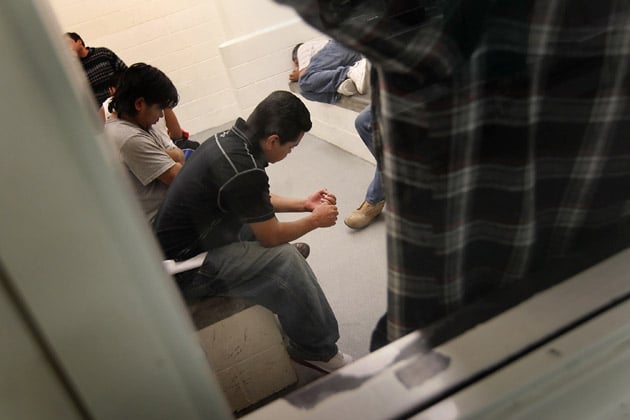
Undocumented Mexican immigrants wait to be deported from the Immigration and Customs Enforcement (ICE) center on April 28, 2010, in Phoenix. (John Moore/Getty Images)
The government recently unveiled a new set of rules outlining better care for immigrants and asylum seekers detained while waiting for their deportation hearings.
The guidelines, issued by the Immigration and Customs Enforcement service (ICE), have been assailed by congressional Republicans, who say they amount to coddling illegal immigrants.
The controversy heated up last week in a hearing called "Holiday on ICE," held by Rep. Lamar Smith, R-Texas, who has referred to the new rules as "a hospitality guideline for illegal immigrants." He pointed in particular to a new federal facility in Texas that the administration has held up as an example of a less penal approach to non-criminal immigration detainees. The guards there don't wear uniforms, and the facility has, as Smith pointed out, a soccer field, volleyball court and cable TV. The $32 million center was built by a private contractor, and ICE claims it will cost less per day to house detainees there than in other facilities.
Smith, as well as the head of the union representing ICE agents, says the new guidelines are too loose on security, and that the government's focus should be on deporting undocumented immigrants faster. Meanwhile, immigrant rights advocates say detainees who aren't criminal offenders shouldn't be treated as such.
So, what are the new guidelines, and what prompted the changes to ICE's policy?
The government detains about 400,000 illegal immigrants each year. On a given day, roughly 32,000 people are held, about half of them in jails rather than immigrant detention facilities. (PBS' "Frontline" provides a useful history of changes to U.S. detention policy and an interactive map of ICE detention centers.)
The rules, which are gradually taking effect, are meant to address areas of detention that have long been problematic.
Access to medical care: More than 100 immigrants in detention have died since 2003, many from lack of access to medical care or proper medication. The New York Times reported in 2010 that immigration officials covered up many deaths and that few safeguards for transparency were in place. The new guidelines promise better regular medical care, including mental health and separate standards for women's health.
Protection against sexual abuse: The American Civil Liberties Union found 185 reported incidents of sexual abuse between 2007 and 2010. Immigration detention centers are not covered by legislation aimed at reducing prison rape, and the new guidelines are supposed to improve supervision of detainees as well as the process for reporting sexual abuse.
Access to family and legal help: Because detainees are spread across hundreds of facilities, often in isolated areas, and frequently transferred, it was difficult for family members or lawyers to remain in close contact with them. A Human Rights Watch reportfound that 46 percent of detainees were moved at least twice, and 3,600 detainees were transferred 10 times or more. The new guidelines improve access to bilingual interpreters, and call for better communication with families and legal counsels about transfers. (ICE also issued a directive this year to minimize transfers.) Facilities are "encouraged to provide opportunities for both contact and non-contact visitation."
Advocates have pointed out that many aspects of new guidelines and the new Texas facility, such as increased freedom of movement and contact visitation, bring the ICE guidelines in line with the standards at many federal correctional facilities, especially low-security ones.
The government plans to build more facilities like the one in Texas, though most detainees will still find themselves housed in less plush environs. Only about 14 percentare expected to be held in new facilities like the one in Texas.
The administration has continued a policy begun under President George W. Bush in which asylum seekers and undocumented immigrants are detained until their court dates. Arrests and deportations have risen steadily since Obama took office.
The administration is billing the rules and new construction as part of a shift in focus away from non-criminal immigrants to catching and deporting criminal immigrants.
PBNDS 2011 reflects ICE's ongoing effort to tailor the conditions of immigration detention to its unique purpose while maintaining a safe and secure detention environment for staff and detainees. In developing the revised standards, ICE incorporated the input of many agency employees and stakeholders, including the perspectives of nongovernmental organizations and ICE field offices. PBNDS 2011 is crafted to improve medical and mental health services, increase access to legal services and religious opportunities, improve communication with detainees with limited English proficiency, improve the process for reporting and responding to complaints, and increase recreation and visitation.
2011 Operations Manual ICE Performance-Based National Detention Standards (PBNDS)
In keeping with its commitment to reform the immigration detention system, U.S. Immigration and Customs Enforcement (ICE) has revised its detention standards. These new standards, known as Performance-Based National Detention Standards 2011 (PBNDS 2011), represent an important step in detention reform.PBNDS 2011 reflects ICE's ongoing effort to tailor the conditions of immigration detention to its unique purpose while maintaining a safe and secure detention environment for staff and detainees. In developing the revised standards, ICE incorporated the input of many agency employees and stakeholders, including the perspectives of nongovernmental organizations and ICE field offices. PBNDS 2011 is crafted to improve medical and mental health services, increase access to legal services and religious opportunities, improve communication with detainees with limited English proficiency, improve the process for reporting and responding to complaints, and increase recreation and visitation.

No comments:
Post a Comment